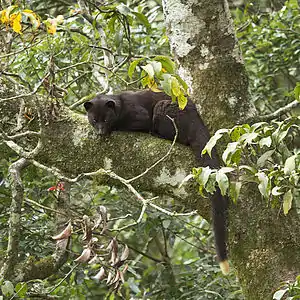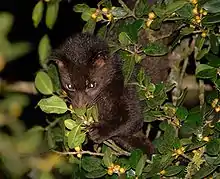Brown palm civet
The brown palm civet (Paradoxurus jerdoni)[2] also called the Jerdon's palm civet is a palm civet endemic to the Western Ghats of India.[1]
| Brown palm civet | |
|---|---|
 | |
| Illustration by Joseph Smit (1885) | |
| Scientific classification | |
| Kingdom: | Animalia |
| Phylum: | Chordata |
| Class: | Mammalia |
| Order: | Carnivora |
| Suborder: | Feliformia |
| Family: | Viverridae |
| Genus: | Paradoxurus |
| Species: | P. jerdoni |
| Binomial name | |
| Paradoxurus jerdoni Blanford, 1885 | |
 | |
| Brown palm civet range | |
Characteristics

The brown palm civet has a uniformly brown pelage, darker around the head, neck, shoulder, legs, and tail. Sometimes the pelage may be slightly grizzled. Two subspecies have been described on the basis of the colour of the pelage although the colour is extremely variable, ranging from pale buff or light brown to dark brown. The dark tail sometimes has a white or pale-yellow tip. It has no distinct markings on the body or the face as in the Asian palm civet. A distinctive feature is the reversed direction of hair growth on the nape, similar to that in the golden palm civet (P. zeylonensis) of Sri Lanka. It is about as large as the common palm civet, but with a long and sleek tail. The body weight of the males ranges from 3.6–4.3 kg (7.9–9.5 lb), head and body length 430–620 mm (17–24 in), and tail length from 380–530 mm (15–21 in).[4][3][5] The species was described in 1885 on the basis of a skull and pelt obtained in Kodaikanal by Mr F. Levinge and forwarded by Rev. S. B. Fairbank to Blanford. Blanford noted the long foramen on the anterior palate. He also found the pelt matching another specimen collected by Francis Day. Blanford named the species in honour of T. C. Jerdon.[6] The subspecies caniscus was described by Reginald Innes Pocock on the basis of a specimen collected at Virajpet in southern Coorg.[7]
There are two subspecies, the nominate P. j. jerdoni and P. j. caniscus.[2] The Sulawesi palm civet is sometimes referred to by the same English name due to its brown colour.[8]
Distribution and habitat

The brown palm civet's distribution extends from the southern tip of Western Ghats in Kalakkad Mundanthurai Tiger Reserve to Castle Rock in Goa to the north.[9] They are nocturnal, and not as rare as previously thought and sight records of the species in Kodaikanal and Ootacamund where they were earlier considered to be locally extinct are an indication of their ability to go unnoticed.[4]
The brown palm civet occurs in fragmented landscapes containing remnants of tropical rainforest amid commercially exploited land patches such as tea and coffee plantations. Their ability to persist in such landscapes depends on the occurrence of a diversity of fruit tree species in these areas such as shade trees in coffee plantations.[10]
Ecology and behaviour

Brown palm civets are solitary and nocturnal. They rest during the day in day-bed sites, such as tree hollows, canopy vine tangles, Indian giant squirrel nests and forks of branches. The day-bed trees are large and are usually in dense mature forest stands with high canopy connectivity. They sometimes rest in the night in open branches.[11]
Diet

The brown palm civet is a key mammalian seed disperser in the Western Ghats rainforest by being predominantly frugivorous and dispersing a diverse array of plant species. Fruits form a large proportion (97 per cent) of its diet and more than 53 native and four introduced species of plants have been recorded. The diet patterns vary across years and even within the same year. They adapt to climatic variations in fruit availability by feeding on a diverse range of species of invertebrates and vertebrates. They eat fruits of trees and lianas, rarely those of herbs or shrubs. The diet is mostly composed of small (<1 cm diameter), many seeded, pulpy berries, and drupes with moderate to high water content, along with several large (>2 cm) fruits like Palaquium ellipticum, Elaeocarpus serratus, Holigarna nigra, and Knema attenuata.[12] They have also been recorded feeding on flowers such as those of Cullenia exarillata[13] and Syzygium species.[12]
Conservation
Because of its large range and presence within several protected areas it has been classified as being of low conservation concern. However, these areas often do not have large mammalian dispersers and birds like hornbills and large pigeons due to habitat loss and hunting. Hence, the brown palm civet gains importance in such human-impacted landscapes as an important disperser and maintains biodiversity.[14]
References
- Mudappa, D.; Choudhury, A. & Punjabi, G.A. (2016). "Paradoxurus jerdoni". IUCN Red List of Threatened Species. 2016: e.T16104A45201757. Retrieved 30 October 2018.
- Wozencraft, W.C. (2005). "Paradoxurus jerdoni". In Wilson, D.E.; Reeder, D.M (eds.). Mammal Species of the World: A Taxonomic and Geographic Reference (3rd ed.). Johns Hopkins University Press. p. 551. ISBN 978-0-8018-8221-0. OCLC 62265494.
- Blanford, W. T. (1885). "A Monograph of the Genus Paradoxurus, F. Cuvier". Proceedings of the Zoological Society of London. 53: 780–808. doi:10.1111/j.1096-3642.1885.tb02921.x.
- Rajamani N.; Mudappa, D. & Van Rompaey, H. (2002). "Distribution and status of the Brown Palm Civet in the Western Ghats, South India" (PDF). Small Carnivore Conservation. 27: 6–11. Archived from the original (PDF) on 28 July 2011.
- Blanford, W.T. (1888–91). Fauna of British India. Mammalia. Taylor and Francis, London. pp. 111–112.
- Blanford, W.T. (1855). "Exhibition and description of a skull of an apparently new Species of Paradoxurus (Paradoxurus jerdoni)". Proceedings of the Zoological Society of London: 612–613.
- Pocock, R.I. (1933). "The Palm Civets or 'Toddy Cats' of the genera Paradoxurus and Paguma inhabiting British India". Journal of the Bombay Natural History Society. 36: 856–877.
- Wilson D.E.; Mittermeier, R.A., eds. (2009). Handbook of the Mammals of the World. Volume 1. Carnivores. Barcelona: Lynx Edicions.
- Kinnear, N. B. (1913). "The Brown Palm-Civet in North Kanara". Journal of the Bombay Natural History Society. 22: 390.
- Mudappa, D.; Noon, B.R.; Kumar, A. & Chellam, R. (2007). "Responses of small carnivores to rainforest fragmentation in the southern Western Ghats, India" (PDF). Small Carnivore Conservation. 36: 18–26. Archived from the original (PDF) on 28 July 2011.
- Mudappa, D. (2006). "Day-bed choice by the brown palm civet (Paradoxurus jerdoni) in the Western Ghats, India". Zeitschrift für Säugetierkunde. 71 (4): 238–243. doi:10.1016/j.mambio.2006.01.003.
- Mudappa, D.; Kumar, A. & Chellam, R. (2010). "Diet and fruit choice of the brown palm civet Paradoxurus jerdoni, a viverrid endemic to the Western Ghats rainforest, India" (PDF). Tropical Conservation Science. 3 (3): 282–300.
- Ganesh, T. & Davidar, P. (1997). "Flowering phenology and flower predation of Cullenia exarillata (Bombacaceae) by arboreal vertebrates in Western Ghats, India". J. Tropical Ecology. 13: 459–468. doi:10.1017/S0266467400010622.
- Ashraf, N.V.K.; Kumar, A. & Johnsingh, A.J.T. (1993). "Two endemic viverrids of the Western Ghats, India". Oryx. 27: 109–114. doi:10.1017/S0030605300020640.
External links
| Wikispecies has information related to Paradoxurus jerdoni. |
